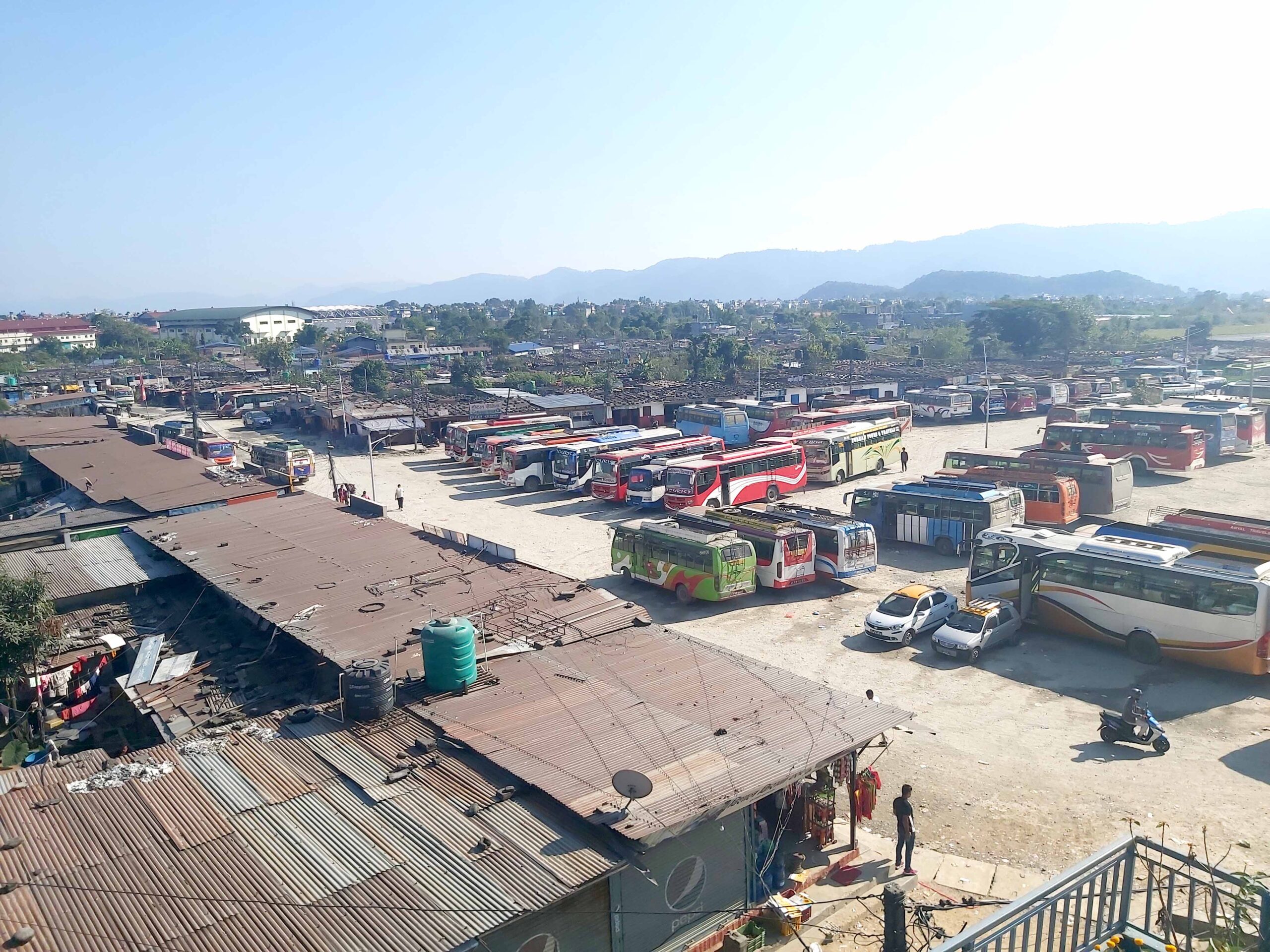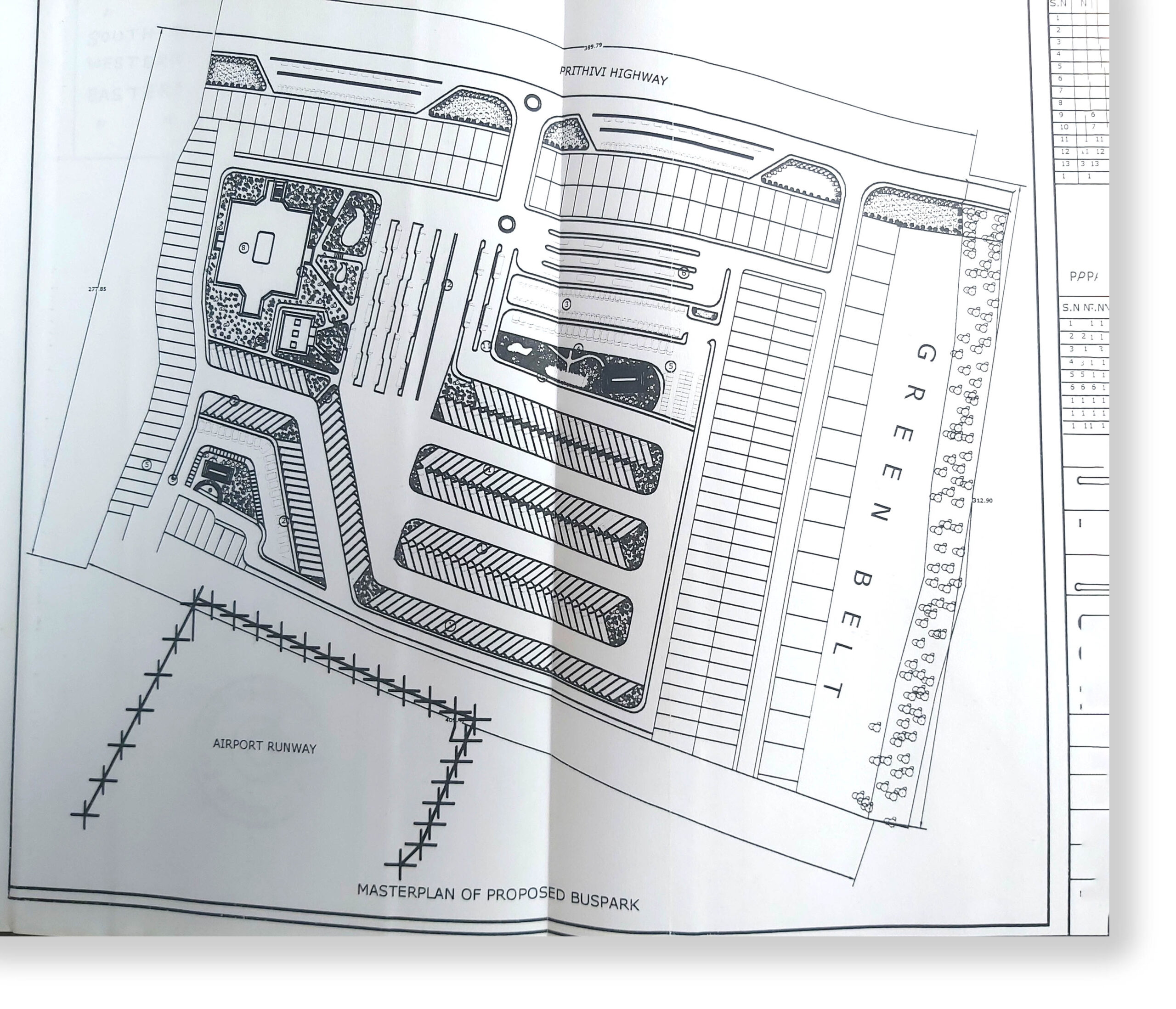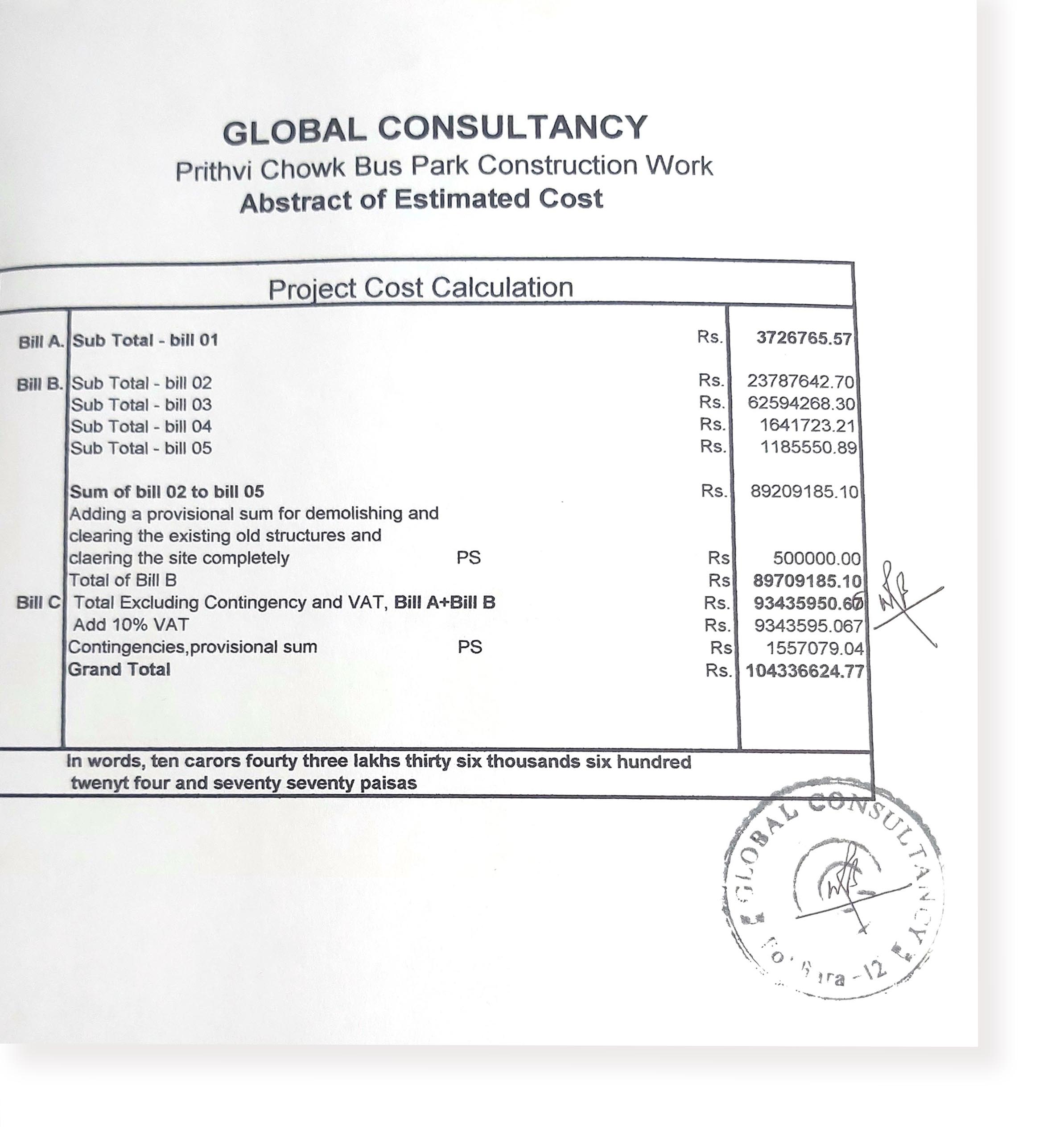The Pokhara bus park project, conceived 47 years ago, remains in limbo, with its land embezzled and captured by squatters.
Shyam Rana Magar |CIJ, Nepal
The Pokhara Bus Park was envisioned 47 years during the Panchayat era but its work is yet to begin. The land acquired for the bus park is today not a construction site but a playground for policy corruption and encroachment. Of the 205 ropani land acquired, only 47 ropani remains for the bus park today.
Pokhara’s Prithvi Chowk is a junction where two highways, Prithvi and Siddhartha, meet. The Pokhara Valley Development Committee had prepared the masterplan to construct a bus park at this junction in 1975, when Shankar Raj Pathak was the Gandaki’s zonal commissioner.
On March 1, 1976, a 205 ropani land was acquired under the Land Acquisition Act, 2018BS, publishing a notice in the national gazette. The land fell between Seti’s bank on the east, the horse way from Prithvi Highway to the airport on the west, the highway on the north and Seti Gandaki river on south.

Pokhara bus park photo: Shyam Rana Magar
When the acquired land was checked, it was short of its stated area by 8 ropani 4 aana 2 paisa and 3 daam. The Prithvi Highway widening project took further 8 ropani 3 aana 1 paisa and 2 daam area from the bus park’s land. Now there remains a total of 188 ropani 7 aana 3 paisa 3 daam for the bus park project, various reports show.
But of the remaining 188 ropanis, the sloped land on the banks of Seti, Fusre and Bijayapur rivers was not fit for any infrastructure construction, according to a joint study conducted in 1998 by the Department of Mines and Geology and GeoScience Institute of Germany. The study report states that no infrastructure should be constructed at a distance of at least 50 meters from these rivers.
According to the study, the 67 ropani 11 aana 3 paisa land across the Seti river that had developed cracks was also not fit for the bus park. Now the bus park project only had 120 ropani 12 aana 3 daam suitable for it. That land too has been shrinking over the years thanks to encroachment and the concerned authorities’ faulty moves.
Patches for private building on acquired land
While the land was acquired for the bus park, neither were the landowners compensated timely nor did the construction start. With so much dilly-dallying, the officials concerned themselves began to embezzle the project’s property.
Many studies at different times point to the officials’ bad intentions in the project’s failure. The result was: the acquired land became not a site of the bus park but the playground for people to earn.
After Pokhara airport’s upgrade, as many as 74 households, including 49 hoteliers, were sold the airport’s land in October 1977. Document from the development committee shows that of the people whose land was acquired, one was compensated with cash while six others were offered land itself.
Officials of the committee began to repeat the same mistake. Instead of focussing on constructing the bus park, the committee often provides land itself as compensation while sometimes focussing on building ‘safe residential homes’ instead.
Bus Park’s land, private ownership
On January 16, 1987, eleven years after the decision to construct the bus park, the committee’s meeting decided to provide land itself as compensation to those from whom it was acquired in the first place—at the rate of 7 aana 3 daam. But the decision was not implemented citing the land owners didn’t agree to it.
Afterwards, the committee’s meeting on April 5, 1996 and June 2, 1996 decided to provide 7 aana 3 daam land to each ropani land acquired. Then another meeting on June 16, 2003 made another decision to distribute 8*20 metre land for each ropani. The decision was implemented. Ashok Palikhe was the chair of the committee then.

A study committee formed in 2007 in leadership of Krishna Bahadur Gurung states that after the committee’s 2003 decision, the dispute between the committee and landowners was settled. The study report also mentions that the committee distributed land as compensation between February 1, 2005 and April 24, 2006. Moreover, the panchayat sold land cheaply to those traders relocated from ahead of the airport.
So as much as 20 ropani 5 aana 2 paisa 2 daam land meant for the airport was distributed as compensation. Likewise, 16 ropani 14 aana 1 paisa 3 daam land was sold cheaply to 74 people.
The Gurung-led study committee mentions several issues with the development committee’s decision, such as lack of consensus in distributing compensation and sale of land; no permission taken from the concerned ministry or department; and lack of trial check in the real area of the owner’s land.
Sale of land and compensation introduce further trouble
The acquired land kept on shrinking. The committee decided to acquire the land of one local Kalyani Bhari for Prithvi Highway’s upgrade project and Prithvi Chowk widening and provided her with the bus park’s land as compensation.
According to a June 4, 2003 decision, the committee provided Bhari with the 3 aana 3 paisa land of kitta number 8442 and 4 aana 1 paisa 3 daam land of kitta number 8663—a total of 8 aana 3 daam.
The committee rented out the bus park’s 7 aana 1 paisa 1 daam land to a petrol pump entrepreneur in 1977. After the rent contract was over in 1987, the committee sold the land to the owner Devendra Kayastha at Rs4.2 million per ropani.
The committee had already sold a total of 16 ropani 14 aana 1 paisa 3 daam land to the 74 hoteliers relocated from ahead of airport to bus park. The committee’s documents show that each of the hoteliers got about 3 aana 3 paisa land. According to the document, the price of the land is uneven—varying from Rs180,000 to Rs300,000 for the same land.
Of the 74 hoteliers, 31 have been charged at the rate of Rs300,000, 32 Rs180,000, and 11 Rs260,000. So it seems that the main culprit behind the project’s failure seems to be the committee itself.
Embattled from the very beginning
The project conceived in 1975 was said to be completed during the royal rule. The committee under Ashok Palikhe in 2003 prepared a map and design. The design prepared by Global Consultancy Company stipulated that the bus park would accommodate 530 buses and it would cost Rs58.4 million.
The committee has decided to settle the compensation and management issues for the bus park that would lessen Pokhara’s traffic density for 15 years. But two decades after that design, construction of the bus park is not in sight.

Kshetra Bahadur KC, who succeeded Palikhe as committee chief on October 1, 2003, got embroiled in land distribution and sale controversy. He was accused of selling the land at a cheap rate and embezzling the committee’s property. He resigned from his post on October 11, 2004.
After KC came Bishnu Prasad Bastola, who chaired the committee until November 1, 2006. Asked about the decisions and work during his tenure, Bastola says, “Whatever embezzlement happened was during Kshetra Bahadur KC’s tenure. I don’t know anything else.”
Ashok Palikhe, who served as committee chair for two terms before KC, says that the bus park project was caught in limbo after 40 households apart from the 34 that ran hotels ahead of the airport were also compensated with land.
“The committee during the Panchayat era sold land at a cheap rate, arguing the bus park would require human settlement,” he says. “That was what introduced trouble to the project.”
But it was Palikhe himself who chaired the committee that decided to compensate land acquisition with land itself. He claims that there was no other option than that to immediately solve the problem then. He insists that he formed a committee in 2002 and decided to provide land at rate of 4 aana 3 paisa to resolve the dispute.
“I moved the work forward by distributing 3 percent of the land acquired,” Palikhe says. “My second term expired while doing that and couldn’t take the work any further.”
More controversy in compensation and sale
The decision of the Palikhe-led committee also hindered construction of the bus park. It distributed land at rate of 3 aana 3 paisa (8*15m) and five aana (8*20m) to those whose lands were acquired.
But documents show that for those whose 4 ropani land was acquired, the committee distributed more compensation than required. For instance, one Gajendra Bhakta Palikhe, whose 62 ropani 13 aana land was acquired, was provided with 32 land suitable for house construction; Tikaram Bastola, whose 13 aana 3 daam land was acquired, was given 17 patches of land. Seven such people were overcompensated.
Meanwhile, of the hoteliers relocated from ahead of the airport, land was sold in the name of all of one family members and a single family was compensated twice.
Squatters at the bus park
Another of Pokhara bus park project’s problems are the squatters. At the project’s land are 400 squatter families now. Residents of Prithvi Chowk say that they began to settle down at the bus park’s land in 1979/80 and the settlement thickened after 1999/2000.
At around 36 ropani of the land are settlements such as Ganatantrik, Krishna and Shiva toles. Tole development committees and aama samuha (mothers’ groups) are active there.
A survey conducted when Jeet Bahadur Gurung was chair of the committee, in 2011, showed that as many as 254 landless squatters were living in the area. Another study committee led by Ram Raj Lamichhane, then chair of Pokhara ward 9, presented a report that the area now had 291 squatter families in 2018.
Rupa KC, chair of Krishna tole aama samuha, said that if the government provided them with a suitable resettlement plan, they wouldn’t hinder bus park construction. “Most of us here are daily wage workers,” she says. “If we get better options, we are ready to leave this place.”
Likewise, Krishna Bahadur Pariyar, chair of Ganatantrik tole development committee, says that unless they are provided with better settlement options, the bus park’s problem wouldn’t be resolved. Prem Gurung, chair of Land Rights Forum Kaski and chair of Krishna tole development committee, says that they wouldn’t vacate the land unless they get a better option.
Bus park in two years now!
After Nepal adopted federalism, the Local Government Operation Act, 2074BS made the provision of the Mayor to be the chair of the city development committee. After the Act was implemented, Man Bahadur GC became the mayor of Pokhara, who formed a study committee twice to resolve the squatter problem and construct the bus park.
Both committees, chaired by ward chiefs, submitted reports that said bus park should not be constructed in an area less than 100 ropanis and for that the squatter problem be resolved. The work under Mayor GC for the project was as much.
The incumbent Mayor Dhanraj Acharya says he will construct the bus park anyhow. “Pokhara is the country’s largest metropolis in terms of area and it is also called the tourism capital. But it’s not fitting that the bus park’s land has squatter settlements and vehicles are parked on the roadsides,” Acharya says. “We will complete this project that has remained in limbo for all these years.”
He further claimed that his office would take help from Urban Development and Land Management ministries to resolve the problems. Mayor Acharya is into 10 months of his five year term and he claims he will prepare a DPR within the first year and start work from the next.
But given the old settlement at the bus park’s land and the ‘politics of vote’, there’s little reason to believe that Acharya’s commitment would materialize.
No progress in Lame Aahal either
According to data from Transport Management Office, Kaski, as many as 292,807 vehicles have been registered in the district until August 9, 2022. Of them, 10,204 are buses, mini buses and mini trucks. Traffic police estimates as many as 10,000 vehicles arrive in Pokhara from other districts daily.
In 1999, the then Lekhnath Municipality’s first city council had decided to build a bus park to reduce traffic density by constructing a regional bus park at Lame Aahal in Pokhara-32. For which, 236 ropani land was allocated.
Akkal Bahadur Karki, chair of Pokhara-32, says that while a DPR has been prepared, they are yet to conclude on how to compensate the land owners. The DPR shows that as much as Rs350 million is required to distribute compensation, Karki said.
Ram Bahadur Paudel, a local leader, says that for traffic management in the city, the issue of the old bus park should be resolved first. “First off, whatever land was allocated for the bus park should be used for the stated purpose,” he says. “After which, we can move on to other options as necessary.”
Aananda Raj Mulmi, a businessman and former chair of Nepal Chamber of Commerce Gandaki, says that it is high time the issues related to the bus park be resolved. “For a well-managed city, management of traffic is the primary prerequisite,” he says.



